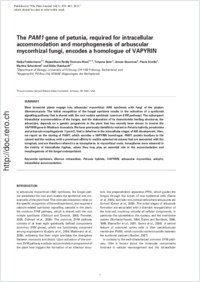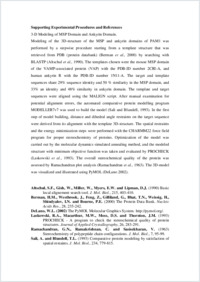The PAM1 gene of petunia, required for intracellular accommodation and morphogenesis of arbuscular mycorrhizal fungi, encodes a homologue of VAPYRIN
- Feddermann, Nadja Department of Biology, University of Fribourg, Switzerland
- Duvvuru Muni, Rajasekhara Reddy Department of Biology, University of Fribourg, Switzerland
- Zeier, Tatyana Department of Biology, University of Fribourg, Switzerland
- Stuurman, Jeroen Keygene NV, Wageningen, the Netherlands
- Ercolin, Flavia Department of Biology, University of Fribourg, Switzerland
- Schorderet, Martine Department of Biology, University of Fribourg, Switzerland
- Reinhardt, Didier Department of Biology, University of Fribourg, Switzerland
-
28.09.2010
Published in:
- The Plant Journal. - 2011, vol. 64, no. 3, p. 470–481
symbiosis
Glomus intraradices
Petunia hybrida
VAPYRIN
arbuscular mycorrhiza
ankyrin
intracellular accommodation
English
Most terrestrial plants engage into arbuscular mycorrhizal (AM) symbiosis with fungi of the phylum Glomeromycota. The initial recognition of the fungal symbiont results in the activation of a symbiosis signalling pathway that is shared with the root nodule symbiosis (common SYM pathway). The subsequent intracellular accommodation of the fungus, and the elaboration of its characteristic feeding structures, the arbuscules, depends on a genetic programme in the plant that has recently been shown to involve the VAPYRIN gene in Medicaco truncatula. We have previously identified a mutant in Petunia hybrida, penetration and arbuscule morphogenesis 1 (pam1), that is defective in the intracellular stages of AM development. Here, we report on the cloning of PAM1, which encodes a VAPYRIN homologue. PAM1 protein localizes to the cytosol and the nucleus, with a prominent affinity to mobile spherical structures that are associated with the tonoplast, and are therefore referred to as tonospheres. In mycorrhizal roots, tonospheres were observed in the vicinity of intracellular hyphae, where they may play an essential role in the accommodation and morphogenesis of the fungal endosymbiont.
- Faculty
- Faculté des sciences et de médecine
- Department
- Département de Biologie
- Language
-
- English
- Classification
- Biological sciences
- License
-
License undefined
- Identifiers
-
- RERO DOC 27908
- DOI 10.1111/j.1365-313X.2010.04341.x
- Persistent URL
- https://folia.unifr.ch/unifr/documents/302241
Other files
Statistics
Document views: 118
File downloads:
- pdf: 223
- Supplementary material: 140

